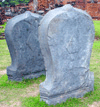Wat Phra Si Sanphet
The royal palace was located here from the
establishment of Ayutthaya in the reign of King Ramathibodi I (1350 A.D.) to
the reign of King Sam Phraya (1448 A.D.) Later, King Borommatrailokanat ordered
a temple (wat) to be built on this site in 1448 A.D. to be utilized as a
monastic area.
After the reign of King Borommatrailokanat, his
son King Ramthibodi ll, ordered the construction of two pagodas (chedis). One
of them was to house the remains of his father and the other those of his
brother, King Borommarachathirat lll. Another pagoda was built by the order of
King Borommarachanophuttangkun. It was similary used to house royal remains
those of King Ramathibodi ll.
 In 1499, a principal Viharn (hall of worship) was built. The following year, in
1500 A.D., King Ramathibodi ll, commanded the casting of a standing Buddha
image 16 meters in height and covered with gold. This image, Phra Buddha Chao
Si Sanphet, was the main object of veneration in the royal Viharn. After that
time the ashes of members of all royal family members and other the kings were
placed in small chedis constructed at the site.
In 1499, a principal Viharn (hall of worship) was built. The following year, in
1500 A.D., King Ramathibodi ll, commanded the casting of a standing Buddha
image 16 meters in height and covered with gold. This image, Phra Buddha Chao
Si Sanphet, was the main object of veneration in the royal Viharn. After that
time the ashes of members of all royal family members and other the kings were
placed in small chedis constructed at the site.
Wat Phra Si San Phet was a royal chapel and as
such did not have a Sangavasa (no monks dwelt there). It was used for royal
ceremonies and rituals including giving alms to the monks from other temples,
and performing the WianTian ceremony on Buddhist holy days, which entails
circumambulating the Viharn three times at night holding an offering of a
candle, flowers and incense.
When Ayutthaya was sacked in 1767 A.D. the gold
that had covered the Buddha image and other decorations was taken by the
invaders. During his reign King Rama l (1782 1809 A.D.) of the Ratanakosin
Period ordered the transfer of the inner core of Phra Buddha Chao Si Sanphet
from Ayutthaya to Wat Phra Chetuphon, Bangkok, and had it placed in a chedi
specially built for the purpose. Another Buddha image of importance called
Phralokanat was also brought to this wat at around the same time.
The remains of ceramic water pipes were found In
the grounds of Wat Phra Si Sanpeht, testimony to the architectural and cultural
advances in the reign of King Narai the Great.
|
|
|
|